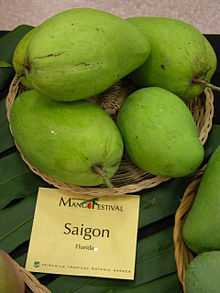Saigon (mango)

'Saigon' is a seedling race of mango cultivars originally introduced to the United States via seed from Southeast Asia.
History
'Saigon' seeds were shipped to the United States from Saigon, Cochinchina in 1902 and planted at the USDA's plant introduction station in Miami, Florida for observation. Edward Simmonds, the station's director, found the fruit to be of good quality[1]
'Saigon' trees mostly came true from seed, though there were some variation. This meant that multiple types of 'Saigon' came into existence, and thus the name covers several varieties.
Because of the positive qualities of the fruit, 'Saigon' was utilized in Edward Simmonds hybridization experiment, which resulted in a cross between a 'Saigon' type and the Indian 'Amini' cultivar. The resulting cross was named 'Samini'.
'Saigon' was also a parent of other mangoes in Florida as well, including the 'Florigon',[2] whose name is a cross between the words 'Florida' and 'Saigon'. 'Saigon' was also claimed to be a parent of the 'Glenn' mango.
'Saigon' trees are planted in the collections of the USDA's germplasm repository in Miami[3] and the University of Florida's Tropical Research and Education Center in Homestead, Florida.[4]
Description
The fruit have an oval to ovate shape with a pointed apex and often have a small lateral beak. The fruit average under a pound in weight at maturity and have green to yellow skin, sometimes developing some light pink blush. The yellow flesh is completely fiberless and has a mild sweet flavor and aroma. 'Saigon' fruit contains a polyembryonic seed and typically matures from June though July in Florida.
'Saigon' trees are considered vigrious growers, developing medium-sized, open, and rounded canopies.[5]
References
- ↑ Dorn, Harold W. (1956). "Mango Growing Around Early Miami". Tequesta: 45. Retrieved 5 May 2011..
- ↑ Geo. D. Ruehle (1947). "Report of Subtropical Fruit Committee" (60). Proc. Fla. State Hort. Soc. pp. 188–195.
- ↑ http://www.ars-grin.gov/cgi-bin/npgs/acc/display.pl?1027708 USDA, ARS, National Genetic Resources Program. Germplasm Resources Information Network - (GRIN). [Online Database] National Germplasm Resources Laboratory, Beltsville, Maryland.
- ↑ http://trec.ifas.ufl.edu/crane/pdfs/TREC-Fruit-Collections.pdf Page 3, #93
- ↑ Campbell, Richard J. (1992). A Guide to Mangos in Florida. Fairchild Tropical Garden. p. 151. ISBN 0-9632264-0-1.
| ||||||||||||||||||||||